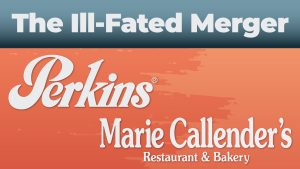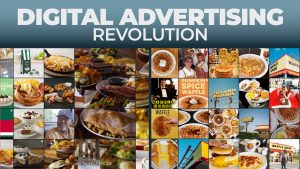Perkins’ marketing missteps have been felt in Omaha and throughout the country. Perkins, once a beloved restaurant chain known for its all-day breakfast and mammoth-sized muffins, is now facing a dire struggle to keep its doors open. In contrast to its heyday in the late ’50s and ’60s, recent years have seen Perkins grappling with bankruptcy filings and dwindling patronage.
What went wrong? It’s a tale of missed opportunities and a failure to adapt to the changing marketing landscape, particularly in the age of TikTok, Instagram, and Facebook. In this article, we’ll explore the reasons behind Perkins’ downfall, drawing parallels with successful competitors like Waffle House and IHOP who embraced marketing innovations and thrived.
Let’s explore Perkins’ marketing missteps along the way.
Embracing Tradition While Ignoring Modern Trends
Perkins’ Legacy and Early Success
Perkins, a restaurant and bakery chain that has been in existence for over six decades, has seen its fair share of transformations. From initially offering only breakfast to expanding into an all-day restaurant, adding in-store bakeries, and introducing sport-themed rooms, Perkins showed an ability to adapt. However, these changes did not secure its long-term success.
The Ill-Fated Merger with Marie Callender’s
Perkins’ Merger with Marie Callender’s.

In 2006, Perkins joined forces with California-based Marie Callender’s, both institutions dating back to the ’60s. This merger, initially promising, failed to shield the chain from a series of financial troubles. The housing crash of 2008 and the subsequent recession dealt a severe blow, leading to the closure of numerous Perkins and Marie Callender’s outlets.
A Franchisee Feud and a Second Bankruptcy
Franchisee Troubles and Second Bankruptcy:
A significant portion of Perkins’ success relied on its franchises, with a majority of its stores being franchise-owned. However, the failure of one major franchisee, Campbell Land Company, to pay royalties, transfer fees, and marketing fees resulted in legal disputes. This led Perkins to demand the closure of Campbell’s purchased units and marked the beginning of further financial woes. In 2019, Perkins filed for bankruptcy again, citing a lack of customer interest in family and casual dining, rising commodity prices, and increased minimum wages.
Although Franchisees were a large problem for the company, Perkins’s marketing missteps are the reason for the demise of the iconic restaurant brand.
Failing to Innovate and Attract a Younger Audience
Innovation Gap and Fading Appeal

As the dining landscape evolved, Perkins found itself labeled as “old person food,” struggling to connect with a younger demographic. While competitors like Waffle House and IHOP embraced innovation and adapted their menus, Perkins failed to update its offerings to align with current trends and local tastes.
Oversized Real Estate and Changing Consumer Habits
Real Estate Challenges and Changing Consumer Behavior
Perkins’ restaurant size, averaging 6,000 square feet, proved excessive for a chain experiencing a shortage of customers. The shift towards takeout and delivery, accelerated by the pandemic, highlighted the need for a smaller footprint. Perkins, belatedly, recognized the need to adapt its real estate strategy to cater to evolving consumer preferences.
The Impact of COVID-19 on Breakfast Sales
Breakfast Sales Slump Amidst Pandemic
Recognized as a go-to destination for breakfast, Perkins felt the brunt of the pandemic’s impact on dining habits. The breakfast industry suffered a disproportionate decrease in sales compared to lunch and dinner. With more people opting to eat breakfast at home, Perkins faced declining sales and struggled to recover.
Neglecting Franchise Expansion Opportunities
Lack of Franchise Growth
Despite a significant number of franchise-owned stores, Perkins had been slow in actively selling franchises and expanding into non-traditional locations. A lack of franchise sales efforts hampered the brand’s growth potential.
Outdated Advertising Strategies
Outdated Advertising Strategies: A Failure to Embrace a New Era
Perkins’ reluctance to embrace modern advertising strategies proved to be a significant factor in its decline. The chain’s steadfast reliance on traditional advertising channels, such as radio and television commercials, showcased a lack of agility in adapting to the evolving marketing landscape. In an era where digital advertising had not only taken center stage but had also become the primary means of reaching and engaging with consumers, Perkins lagged.
Digital Advertising Revolution

The digital advertising revolution was well underway, with platforms like TikTok, Instagram, and Facebook rapidly gaining prominence. These platforms offered unparalleled opportunities for brands to connect with their target audience on a personal level. Perkins, however, clung to the familiarity of radio and television ads, failing to recognize the shifting media consumption habits of consumers.
User-Generated Content Strategies
One of the defining characteristics of modern marketing is the emphasis on user-generated content. Successful brands were not just broadcasting their messages but actively engaging with their audience. TikTok, for instance, provided a dynamic platform where users could create and share content related to their favorite brands and experiences. Unfortunately, Perkins largely overlooked the potential of user-generated content in amplifying its brand presence.
The Power of TikTok and Instagram
TikTok, with its short-form video format, had become a cultural phenomenon, particularly among younger consumers. Brands that harnessed the creativity of TikTok users experienced viral success and saw their products or services becoming trends overnight. Perkins’ absence from this vibrant platform meant missing out on an opportunity to tap into the Gen Z and millennial demographics.
Similarly, Instagram’s visually rich environment offered an ideal canvas for food-related content and restaurant promotions. Influencers and food bloggers were actively shaping culinary trends and dining choices. While competitors leveraged these influencers to showcase their menus and engage with a wider audience, Perkins remained largely absent from this influencer-driven ecosystem.
The Consequences of Reducing Spend and Abandoning Strategy
Perkins’ steadfast adherence to traditional advertising not only hindered its ability to stay relevant but also led to a noticeable disconnect with younger generations. While Waffle House and IHOP successfully engaged with Gen Z and millennials on social media, Perkins remained on the periphery of these conversations. This outdated marketing approach ultimately contributed to a decline in brand awareness and a loss of customer interest.
Perkins’ reluctance to adapt its advertising strategies to the digital age, coupled with its failure to harness the power of user-generated content on platforms like TikTok and Instagram, played a pivotal role in its struggles and the closure of numerous stores. The iconic American brand’s inability to keep pace with the evolving marketing landscape serves as a stark reminder of the critical importance of staying agile and embracing modern marketing techniques in today’s highly competitive business environment.
Neglecting SEO and Local Search Optimization
Perkins’ failure to embrace SEO (Search Engine Optimization) and local search optimization represented a critical missed opportunity to connect with a new customer base. In today’s digital age, where the majority of consumers wield smartphones equipped with voice-activated assistants like Siri, Alexa, and Google Assistant, the power of online search cannot be overstated. Yet, Perkins seemed to have overlooked the immense potential of leveraging this trend to their advantage.
The Rise of Voice-Activated Search

With the proliferation of smartphones, voice-activated search has become the norm for many consumers seeking information about local businesses, including restaurants. Queries like “best pie near me” or “breakfast near me” are increasingly common, and they present a golden opportunity for businesses to appear at the top of search results. However, Perkins seemed to miss the boat on optimizing its online presence for such local searches.
Local SEO and Mobile Devices

Local SEO strategies involve optimizing a business’s online presence to ensure it ranks prominently in search engine results when users search for products or services in their immediate vicinity. Mobile devices, such as iPhones, have become the primary tool for conducting these searches, especially when users are on the go and seeking nearby dining options. Perkins’ lack of investment in local SEO meant that it was less likely to appear in the search results when potential customers were looking for breakfast or pie nearby.
Online Reviews and Decision-Making
In addition to voice-activated search, consumers heavily rely on online reviews and ratings to make informed decisions about where to dine. Whether searching for the “best breakfast spot” or “top-rated pie bakery,” users expect search engines to deliver not just a list of options but also user-generated insights into the quality of these establishments. Perkins missed out on the opportunity to proactively manage its online reputation and encourage satisfied customers to leave positive reviews, thus bolstering its image among potential diners.
Automatic Information Delivery
Today’s consumers have grown accustomed to receiving information at lightning speed. When they ask Siri or Google for recommendations, they expect instantaneous and relevant results. Perkins, with its decades of history, could have harnessed the power of local SEO to ensure that its name and offerings appeared at the top of these search results. By failing to do so, they risked becoming invisible to a vast audience that relies on quick, AI-driven recommendations for their dining choices.
A Blind Spot That Even a Massive Franchise Missed
Perkins’ oversight in neglecting SEO and local search optimization represented a significant blind spot in its marketing strategy. In an era where the majority of consumers turn to their smartphones and voice-activated assistants for restaurant suggestions, Perkins missed the opportunity to connect with a new customer base. By not optimizing its online presence for local searches, the iconic brand inadvertently limited its visibility and accessibility to potential patrons. In a world where information is served in a nanosecond, Perkins’ failure to adapt to the changing landscape of consumer behavior contributed to its struggles and the closure of numerous stores.
Perkins’ marketing missteps caused unforeseen challenges.
Unforeseen Challenges: Fires and Labor Shortages
Unforeseen Challenges
In addition to financial struggles, Perkins faced unforeseen obstacles, including fires that temporarily forced some locations to close. Moreover, the restaurant industry grappled with a labor shortage exacerbated by the pandemic, making it difficult for Perkins to fully operate its outlets.
The Decline of Chain Restaurants
Cultural Shift and the Decline of Chain Restaurants
Perkins’ struggles cannot be attributed solely to pandemic-related issues. A broader cultural shift away from chain restaurants was already in motion. With changing consumer preferences and increased competition from various dining options, Perkins found itself in an increasingly challenging market.
The Nostalgia Factor
In an era marked by a growing preference for unique and locally sourced dining experiences, Perkins had a hidden ace up its sleeve—the nostalgia factor. Having been in operation since 1958, Perkins had woven itself into the fabric of American dining culture. For many, Perkins evoked fond memories of family breakfasts and late-night pie outings. This sense of nostalgia could have been harnessed to create a unique selling proposition, setting Perkins apart from newer, trendier competitors.
Unfortunately, Perkin’s marketing missteps continued. They failed to capitalize on on marketing nostalgia to a younger demographic.
Waffle House’s Success
Waffle House, a similar chain with a history dating back to the 1950s, provides an excellent example of how a brand can capitalize on nostalgia and appeal to new generations. Waffle House embraced its retro aesthetic, celebrating its classic diner atmosphere. This approach resonated with both long-time patrons who cherished nostalgia and younger consumers seeking an authentic dining experience. By doing so, Waffle House not only retained its loyal customer base but also attracted a new wave of diners.
Missed opportunities were just another one of Perkins’ marketing missteps.
Missed Opportunities
Perkins, on the other hand, struggled to translate its rich history into a compelling narrative that would resonate with today’s consumers. While the brand continued to serve classic dishes like mammoth-sized muffins and made-from-scratch pancakes, it failed to position itself as a destination for those seeking a nostalgic dining experience. Perkins could have leveraged its decades-long presence to showcase its enduring appeal and convey a sense of authenticity that many modern establishments lack.
Connecting with Newer Generations
To connect with newer generations, Perkins could have embraced a multi-pronged approach. This might have included revamping its branding to celebrate its iconic status, creating marketing campaigns that played on nostalgia, and actively engaging with younger demographics on social media platforms like TikTok and Instagram. By blending tradition with innovation, Perkins could have introduced its time-honored brand to a new audience while retaining the loyalty of its existing patrons.
Perkins’ neglect of SEO and local search optimization was not only a missed opportunity in the digital realm but also a failure to capitalize on its rich history and nostalgia. While the landscape of dining in America was evolving, Perkins could have stood as a beacon of tradition and authenticity, attracting both long-time patrons and new generations of diners. The success of brands like Waffle House demonstrated that nostalgia can be a powerful marketing tool when combined with a modern approach. Unfortunately, Perkins’ marketing missteps caused this brand to fall short in making this connection, contributing to its struggles and the closure of numerous stores.
The Exodus of Longtime Franchise Owners
Longtime Locations Closing
Even as Perkins aimed for record sales, some franchise owners opted to permanently close longstanding locations. These closures, driven by various factors, including franchise agreements expiring, signaled deeper issues within the chain.
Perkins’ marketing missteps and decline from a beloved breakfast spot to a struggling restaurant chain serves as a cautionary tale of the importance of marketing in today’s rapidly evolving landscape. While competitors like Waffle House and IHOP successfully embraced modern marketing strategies, Perkins clung to tradition, ultimately faltering in the face of changing consumer preferences and digital trends.
Perkins once had locations dotting the map in Omaha and throughout the country. Today, only one location still exists near Omaha’s Eppley Airfield, serving as a poignant reminder of the brand’s past glory and the imperative need for adaptation and innovation in an ever-evolving culinary landscape.
To survive and thrive in the restaurant industry, staying ahead of the marketing curve is essential, as Perkins learned the hard way.






